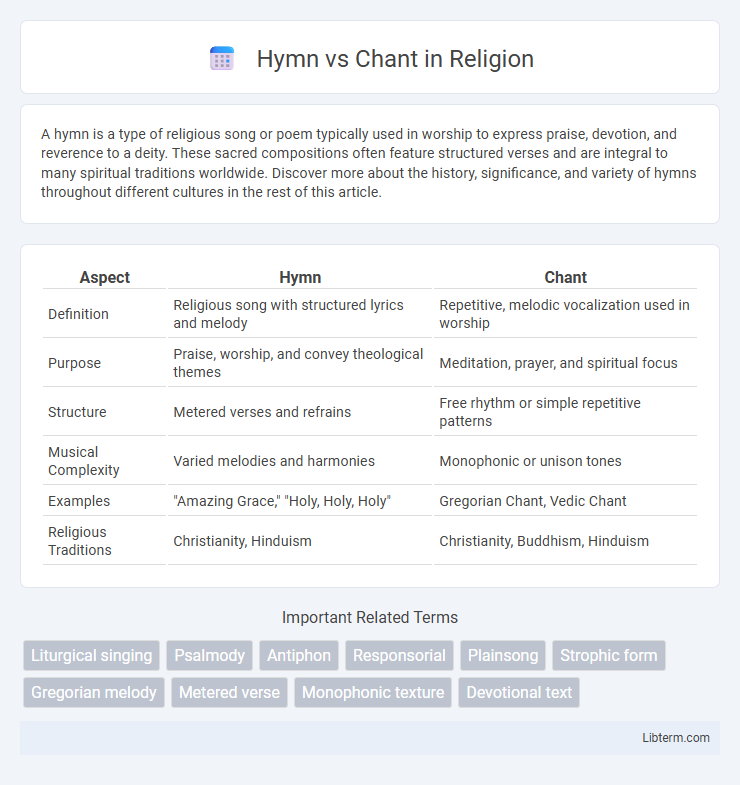A hymn is a type of religious song or poem typically used in worship to express praise, devotion, and reverence to a deity. These sacred compositions often feature structured verses and are integral to many spiritual traditions worldwide. Discover more about the history, significance, and variety of hymns throughout different cultures in the rest of this article.
Table of Comparison
| Aspect | Hymn | Chant |
|---|---|---|
| Definition | Religious song with structured lyrics and melody | Repetitive, melodic vocalization used in worship |
| Purpose | Praise, worship, and convey theological themes | Meditation, prayer, and spiritual focus |
| Structure | Metered verses and refrains | Free rhythm or simple repetitive patterns |
| Musical Complexity | Varied melodies and harmonies | Monophonic or unison tones |
| Examples | "Amazing Grace," "Holy, Holy, Holy" | Gregorian Chant, Vedic Chant |
| Religious Traditions | Christianity, Hinduism | Christianity, Buddhism, Hinduism |
Understanding Hymns: Definition and Origins
Hymns are structured religious songs typically composed with poetic lyrics and melodies designed for congregational singing, originating from early Christian worship practices. Their definition encompasses both the lyrical content, often praising or invoking divine figures, and the musical form that facilitates communal participation. Understanding their origins reveals roots in ancient Jewish psalms and Greco-Roman poetic traditions, shaping their role in spiritual expression and liturgical rites.
What is a Chant? Key Characteristics
A chant is a form of vocal music characterized by rhythmic, repetitive melodic patterns often used in religious or spiritual contexts. It typically features monophonic texture, free rhythm without strict metric structure, and simple melodic lines that enhance meditative or prayerful experiences. Chants serve as a tool for communal participation and spiritual reflection, distinguished from hymns by their minimalist musical style and lack of harmonic accompaniment.
Historical Evolution: Hymns vs. Chants
Hymns and chants both originated in early religious traditions, with hymns evolving from structured poetic compositions intended for congregational singing, while chants emerged from monophonic melodic recitations often used in liturgical contexts. The historical evolution of hymns reflects increasing complexity in musical arrangement and lyrical content, adapting to diverse denominational practices across centuries. Chants, particularly Gregorian chants, maintained their primarily unaccompanied, modal melodic styles, preserving Ancient and Medieval sacred music traditions in Christian worship.
Structure and Composition Differences
Hymns typically feature a structured poetic form with multiple stanzas and a consistent meter, designed for congregational singing with clear melodic lines. Chants emphasize a more fluid, often monophonic melody without strict rhythmic patterns, commonly employing repetitive phrases and modal scales rooted in liturgical traditions. The composition of hymns relies on lyrical content and harmonic progression, whereas chants focus on meditative vocalization and tonal modality.
Musical Styles: Melody and Harmony
Hymns typically feature structured melodies with harmonized four-part choral arrangements emphasizing vocal unity and rich harmonic texture. Chants often utilize monophonic melodies, characterized by a single, unaccompanied vocal line with limited harmonic variation, creating a meditative and repetitive musical style. The contrast in harmony defines hymns as more harmonically complex, while chants prioritize melodic purity and simplicity.
Liturgical Roles: Hymns and Chants in Worship
Hymns in worship often feature structured stanzas and melodic patterns that support congregational singing, enhancing communal participation during liturgical services. Chants, rooted in ancient traditions, typically involve repetitive, monophonic melodies that facilitate meditative prayer and sacred recitation, fostering a contemplative atmosphere. Both hymns and chants serve distinct liturgical roles by enriching worship experiences through varied musical expressions aligned with theological themes and ritual functions.
Language and Lyrics: Poetic vs. Repetitive
Hymns typically feature carefully crafted poetic language with structured verses that convey theological themes and narrative depth. Chants often rely on repetitive, simple phrases or syllables designed for meditative or ritualistic purposes, emphasizing melodic flow over complex lyrics. The linguistic style of hymns promotes reflection through rich imagery, while chants focus on uniformity and memorability within religious practices.
Cultural Significance Across Religions
Hymns serve as structured, lyrical compositions often integral to Christian worship, embodying theological themes and fostering communal devotion through congregational singing. Chants, prevalent in diverse religious traditions such as Gregorian chant in Christianity and Vedic chant in Hinduism, utilize repetitive melodic phrases to induce meditative states and facilitate spiritual connection. Both forms hold profound cultural significance by preserving sacred texts, reinforcing doctrinal teachings, and enhancing ritualistic experiences across varied faith communities.
Emotional and Spiritual Influence
Hymns evoke deep emotional resonance through structured melodies and poetic lyrics that inspire devotion and communal worship. Chants create a meditative atmosphere with repetitive, minimalist tones that enhance spiritual focus and inner contemplation. Both forms serve as powerful tools for emotional connection and transcendental experience in religious practices.
Modern Usage and Adaptations
Modern usage of hymns predominantly occurs in structured church services, where they maintain a fixed melodic form designed for congregational singing, often accompanied by organs or choirs. In contrast, chants have seen adaptations in both liturgical and secular contexts, incorporating repetitive, meditative vocal patterns that cater to contemporary worship styles and mindfulness practices. Digital platforms and global music collaborations further influence hymns and chants, blending traditional elements with modern rhythms and instrumentation.
Hymn Infographic

 libterm.com
libterm.com